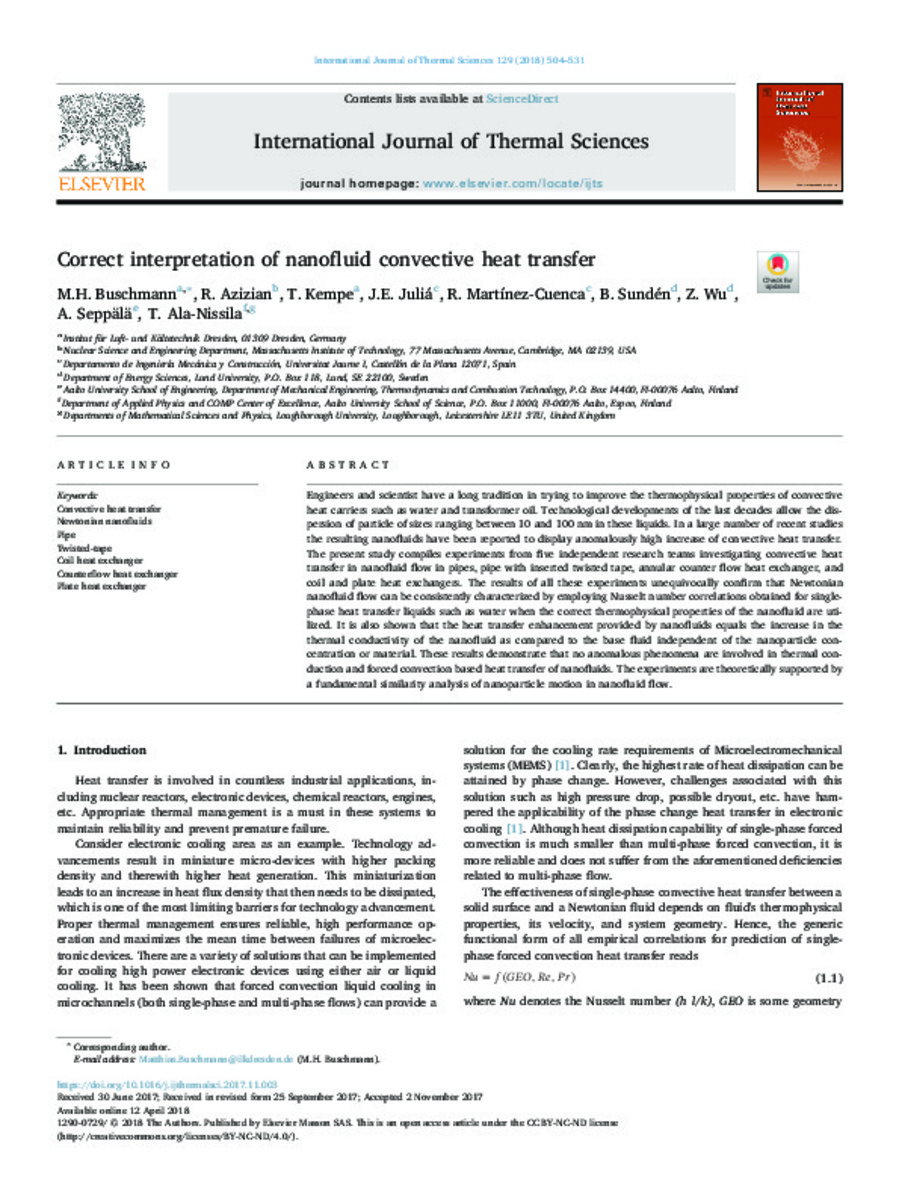Mostrar el registro sencillo del ítem
Correct interpretation of nanofluid convective heat transfer
| dc.contributor.author | Buschmann, Matthias | |
| dc.contributor.author | Azizian, R. | |
| dc.contributor.author | Kempe, T. | |
| dc.contributor.author | Juliá Bolívar, José Enrique | |
| dc.contributor.author | Martinez Cuenca, Raul | |
| dc.contributor.author | Sundén, B. | |
| dc.contributor.author | Wu, Z. | |
| dc.contributor.author | Seppälä, A. | |
| dc.contributor.author | Ala-Nissila, T. | |
| dc.date.accessioned | 2018-05-15T10:10:03Z | |
| dc.date.available | 2018-05-15T10:10:03Z | |
| dc.date.issued | 2018-04 | |
| dc.identifier.citation | BUSCHMANN, M. H., et al. Correct interpretation of nanofluid convective heat transfer. International Journal of Thermal Sciences, 2018, 129: 504-531. | ca_CA |
| dc.identifier.uri | http://hdl.handle.net/10234/174682 | |
| dc.description.abstract | Engineers and scientist have a long tradition in trying to improve the thermophysical properties of convective heat carriers such as water and transformer oil. Technological developments of the last decades allow the dispersion of particle of sizes ranging between 10 and 100 nm in these liquids. In a large number of recent studies the resulting nanofluids have been reported to display anomalously high increase of convective heat transfer. The present study compiles experiments from five independent research teams investigating convective heat transfer in nanofluid flow in pipes, pipe with inserted twisted tape, annular counter flow heat exchanger, and coil and plate heat exchangers. The results of all these experiments unequivocally confirm that Newtonian nanofluid flow can be consistently characterized by employing Nusselt number correlations obtained for single-phase heat transfer liquids such as water when the correct thermophysical properties of the nanofluid are utilized. It is also shown that the heat transfer enhancement provided by nanofluids equals the increase in the thermal conductivity of the nanofluid as compared to the base fluid independent of the nanoparticle concentration or material. These results demonstrate that no anomalous phenomena are involved in thermal conduction and forced convection based heat transfer of nanofluids. The experiments are theoretically supported by a fundamental similarity analysis of nanoparticle motion in nanofluid flow. | ca_CA |
| dc.format.extent | 27 p. | ca_CA |
| dc.format.mimetype | application/pdf | ca_CA |
| dc.language.iso | eng | ca_CA |
| dc.publisher | Elsevier | ca_CA |
| dc.rights | © 2018 The Authors. Published by Elsevier Masson SAS. | ca_CA |
| dc.rights | Attribution-NonCommercial-NoDerivatives 4.0 Internacional | * |
| dc.rights.uri | http://creativecommons.org/licenses/by-nc-nd/4.0/ | * |
| dc.subject | convective heat transfer | ca_CA |
| dc.subject | Newtonian nanofluids | ca_CA |
| dc.subject | pipe | ca_CA |
| dc.subject | twisted-tape | ca_CA |
| dc.subject | coil heat exchanger | ca_CA |
| dc.subject | counterflow heat exchanger | ca_CA |
| dc.subject | plate heat exchanger | ca_CA |
| dc.title | Correct interpretation of nanofluid convective heat transfer | ca_CA |
| dc.type | info:eu-repo/semantics/article | ca_CA |
| dc.identifier.doi | https://doi.org/10.1016/j.ijthermalsci.2017.11.003 | |
| dc.relation.projectID | COST Action CA15119 NANOUPTAKE, supported by COST (European Cooperation in Science and Technology) ; Universitat Jaume I (projects P1-1B2013-43 and UJI-B2016-47) ; Generalitat Valenciana (project VAL-2015-01) ;Ministerio de Economia y Competitividad (project ENE2016-77694-R) ; Bundesministerium für Wirtschaft und Energie, Germany (MF090026) ; | ca_CA |
| dc.rights.accessRights | info:eu-repo/semantics/openAccess | ca_CA |
| dc.relation.publisherVersion | https://www.sciencedirect.com/science/article/pii/S1290072917310748 | ca_CA |
| dc.contributor.funder | nanofluid research program at the Department of Nuclear Science and Technology at MIT ; Alfa Laval AB, Lund and the Swedish Research Council ; Aalto University through its Energy Efficiency Program EXPECTS grant | ca_CA |
| dc.type.version | info:eu-repo/semantics/publishedVersion | ca_CA |
Ficheros en el ítem
Este ítem aparece en la(s) siguiente(s) colección(ones)
-
EMC_Articles [812]








